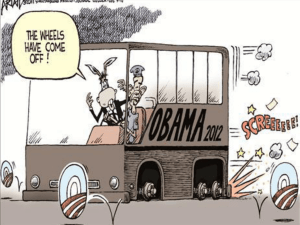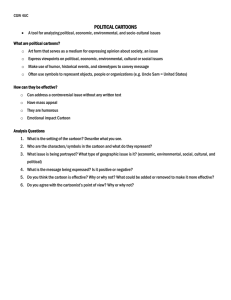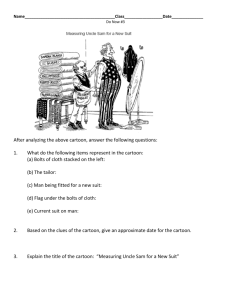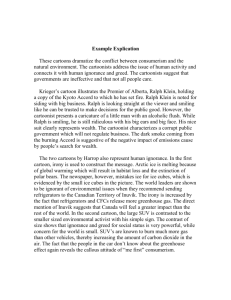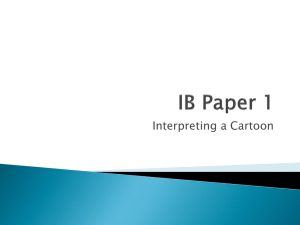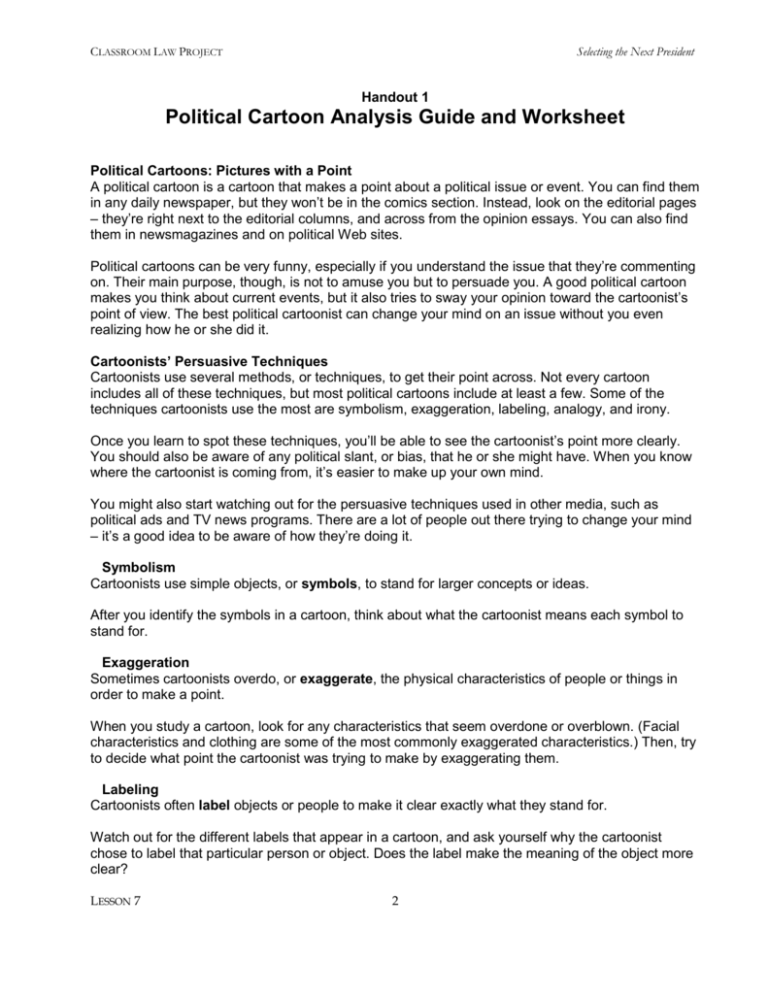
CLASSROOM LAW PROJECT
Selecting the Next President
Handout 1
Political Cartoon Analysis Guide and Worksheet
Political Cartoons: Pictures with a Point
A political cartoon is a cartoon that makes a point about a political issue or event. You can find them
in any daily newspaper, but they won’t be in the comics section. Instead, look on the editorial pages
– they’re right next to the editorial columns, and across from the opinion essays. You can also find
them in newsmagazines and on political Web sites.
Political cartoons can be very funny, especially if you understand the issue that they’re commenting
on. Their main purpose, though, is not to amuse you but to persuade you. A good political cartoon
makes you think about current events, but it also tries to sway your opinion toward the cartoonist’s
point of view. The best political cartoonist can change your mind on an issue without you even
realizing how he or she did it.
Cartoonists’ Persuasive Techniques
Cartoonists use several methods, or techniques, to get their point across. Not every cartoon
includes all of these techniques, but most political cartoons include at least a few. Some of the
techniques cartoonists use the most are symbolism, exaggeration, labeling, analogy, and irony.
Once you learn to spot these techniques, you’ll be able to see the cartoonist’s point more clearly.
You should also be aware of any political slant, or bias, that he or she might have. When you know
where the cartoonist is coming from, it’s easier to make up your own mind.
You might also start watching out for the persuasive techniques used in other media, such as
political ads and TV news programs. There are a lot of people out there trying to change your mind
– it’s a good idea to be aware of how they’re doing it.
Symbolism
Cartoonists use simple objects, or symbols, to stand for larger concepts or ideas.
After you identify the symbols in a cartoon, think about what the cartoonist means each symbol to
stand for.
Exaggeration
Sometimes cartoonists overdo, or exaggerate, the physical characteristics of people or things in
order to make a point.
When you study a cartoon, look for any characteristics that seem overdone or overblown. (Facial
characteristics and clothing are some of the most commonly exaggerated characteristics.) Then, try
to decide what point the cartoonist was trying to make by exaggerating them.
Labeling
Cartoonists often label objects or people to make it clear exactly what they stand for.
Watch out for the different labels that appear in a cartoon, and ask yourself why the cartoonist
chose to label that particular person or object. Does the label make the meaning of the object more
clear?
LESSON 7
2
CLASSROOM LAW PROJECT
Selecting the Next President
Analogy
An analogy is a comparison between two unlike things. By comparing a complex issue or situation
with a more familiar one, cartoonists can help their readers see it in a different light. After you’ve
studied a cartoon for a while, try to decide what the cartoon’s main analogy is. What two situations
does the cartoon compare? Once you understand the main analogy, decide if this comparison
makes the cartoonist’s point more clear to you.
Irony
Irony is the difference between the ways things are and the way things should be, or the way things
are expected to be. Cartoonists often use irony to express their opinion on an issue. When you
look at a cartoon, see if you can find any irony in the situation the cartoon depicts. If you can, think
about what point the irony might be intended to emphasize. Does the irony help the cartoonist
express his or her opinion more effectively?
Once you’ve identified the persuasive techniques that the cartoonist used, ask yourself these
questions:
What issue is this political cartoon about?
What do you think is the cartoonist’s opinion on this issue?
What other opinion can you imagine another person having on this issue?
Did you find this cartoon persuasive? Why or why not?
What other techniques could the cartoonist have used to make this cartoon more
persuasive?
Source: Library of Congress,
http://www.loc.gov/teachers/classroommaterials/presentationsandactivities/activities/politicalcartoon/about.html
LESSON 7
3
CLASSROOM LAW PROJECT
Selecting the Next President
Political Cartoon Analysis Worksheet
Name:
Period:
Date:
1. What is the event or issue that inspired the cartoon?
2. Are there any real people or places in the cartoon? If not, what images are portrayed in the
cartoon?
3. Identify the specific artistic techniques used in the cartoon (i.e., symbolism, analogy,
exaggeration, labeling, and irony). What is the artist trying to show the reader by using these
techniques?
4. What is the cartoonist's point of view about the topic portrayed in the cartoon? Give
examples to support your interpretation.
5. Is this cartoon persuasive? Explain why or why not.
6. What other techniques could the artist have used to make this cartoon more persuasive?
Source: http://www.readwritethink.org/classroom-resources/lesson-plans/analyzing-purpose-meaningpolitical-794.html?tab=3#tabs. Copyright 2005 IRA/NCTE.
All rights reserved. ReadWriteThink materials may be reproduced for educational purposes.
LESSON 7
4



